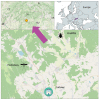Co-Circulation of West Nile, Usutu, and Tick-Borne Encephalitis Viruses in the Same Area: A Great Challenge for Diagnostic and Blood and Organ Safety
- PMID: 36851580
- PMCID: PMC9966648
- DOI: 10.3390/v15020366
Co-Circulation of West Nile, Usutu, and Tick-Borne Encephalitis Viruses in the Same Area: A Great Challenge for Diagnostic and Blood and Organ Safety
Abstract
Viral infections caused by viruses from the family Flaviviridae such as Zika (ZIKV), Dengue (DENV), yellow fever (YFV), tick-borne encephalitis (TBEV), West Nile (WNV), and Usutu (USUV) are some of the most challenging diseases for recognition in clinical diagnostics and epidemiological tracking thanks to their short viremia, non-specific symptoms, and high cross-reactivity observed in laboratory techniques. In Central Europe, the most relevant endemic flaviviruses are mosquito-borne WNV and USUV, and tick-borne TBEV. All three viruses have been recognised to be responsible for human neuroinvasive diseases. Moreover, they are interrupting the blood and transplantation safety processes, when the great efforts made to save a patient's life could be defeated by acquired infection from donors. Due to the trend of changing distribution and abundance of flaviviruses and their vectors influenced by global change, the co-circulation of WNV, USUV, and TBEV can be observed in the same area. In this perspective, we discuss the problems of flavivirus diagnostics and epidemiology monitoring in Slovakia as a model area of Central Europe, where co-circulation of WNV, USUV, and TBEV in the same zone has been recently detected. This new situation presents multiple challenges not only for diagnostics or surveillance but particularly also for blood and organ safety. We conclude that the current routinely used laboratory diagnostics and donor screening applied by the European Union (EU) regulations are out of date and the novel methods which have become available in recent years, e.g., next-gene sequencing or urine screening should be implemented immediately.
Keywords: co-circulation; emergence; flavivirus; mosquito; neuroinvasive diseases; tick.
Conflict of interest statement
The authors declare no conflict of interest.
Figures


References
-
- Cunze S., Glock G., Kochmann J., Klimpel S. Ticks on the move—Climate change-induced range shifts of three tick species in Europe: Current and future habitat suitability for Ixodes ricinus in comparison with Dermacentor reticulatus and Dermacentor marginatus. Parasitol. Res. 2021;121:2241–2252. doi: 10.1007/s00436-022-07556-x. - DOI - PMC - PubMed
-
- Lindström A., Lilja T. First finding of the West Nile virus vector Culex modestus Ficalbi 1889 (Diptera; Culicidae) in Sweden. J. Eur. Mosq. Control Assoc. 2018;36:1–2.
Publication types
MeSH terms
LinkOut - more resources
Full Text Sources
Medical

